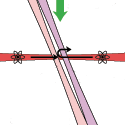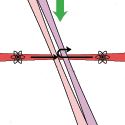Cold atoms on a one-way ticket
In 1871, James Clerk Maxwell imagined a demon perched on a wall separating two rooms, opening a small trapdoor to let fast atoms pass from left to right and slow atoms right to left. Soon, all the hot gas would be on one side, and the cold gas on the other, causing entropy to decrease rather than increase. We now know that the demon itself must increase in entropy, so the second law of thermodynamics is safe. But as Jeremy Thorn, Elizabeth Schoene, Tao Li, and Daniel Steck of the University of Oregon report in the 20 June 2008 issue of Physical Review Letters, it is possible to build the demon’s trapdoor.
Several groups have proposed variants on a one-way gate or “atom diode”. In their version, the Oregon researchers use a laser to confine cooled atoms to a one-dimensional optical trap. A one-way barrier is formed by directing two other laser beams nearly normal to the trap: one beam is tuned so that an atom passing through it is placed in an excited state, while a second adjacent laser provides either a potential barrier or an open path, depending on whether the atom is excited or not. Ground state atoms hitting the barrier beam directly will pass through, but atoms excited by the laser on the other side will be reflected.
These kinds of control techniques may be useful for studying atom trapping, as well as for “atom on a chip” technologies such as miniature atomic clocks. - David Voss





